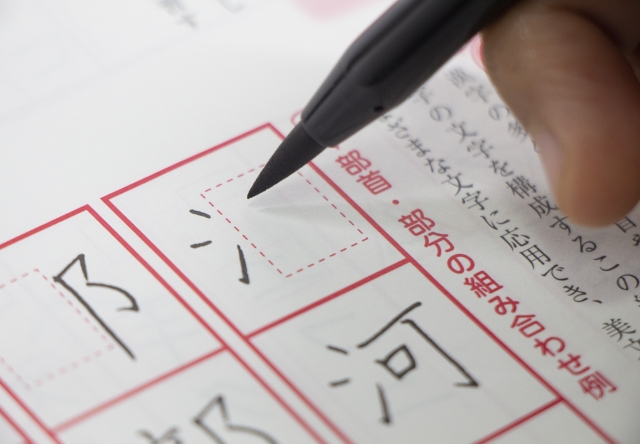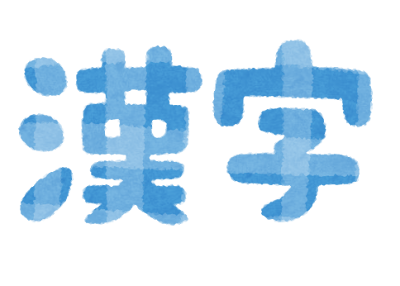The English translation is below
前に漢字習得について書いたブログでは、日本での学習システム
についてのグチみたいになってしまいましたが(汗)
正直学び方は好きではなかったですが、
母国語ゆえ、いい意味でのあきらめ感があって
日本人はみんな受け入れてたんだと思います。
でも漢字自体は嫌いじゃないですよ!というかひらがなとカタカナ
だけでは意味が分かりにくくて逆に不便でしょう
それでは今回は、うってかわって漢字の魅力をお伝えしていきます!

◇文章の意味が明確になる
以前「回文」についてブログを書いたときにも使った文章なんですけど
よのなかねかおかおかねかなのよ
…これだけだとすぐに意味はとれません。でも
世の中ね、顔かお金かなのよ。。。と漢字を混ぜれば
言ってることがすぐに分かると同時に
やるせなさ、までセットで味わえます
次にこの文章を見てください。全部で何羽の鳥がいますか?
うらにわにはにわ にわにはにわにわとりがいる
鳥だけじゃなくて、埴輪(はにわ)もいるんじゃね?
って混乱してしまいます。でも漢字入りだと
裏庭には二羽、庭には二羽鶏がいる
と、合計4羽の鳥がいることが分かります
こりゃ〜漢字がなかったら困りますね
◇一文字あたりに入っている情報量が多い
コンパクトな表現でたくさんの意味を伝えられるんですよ
たった一文字で表せる物の名前もあります
木(き)→ tree. 毛(け)→ hair 血(ち)→ blood
歯(は)→ tooth 胃(い)→ stomach 蚊(か)→ mosquito など
英語と比較するとずっと少ないですよね!
ことわざにしても
kill two birds with one stone も漢字だと
一石二鳥(いっせきにちょう)の四文字です
張り紙でも「ここでは必ず靴を脱いで下さい」より
『土足厳禁』(どそくげんきん)のほうをよく見ると思いますね
遠くに見える立て看板に「この川で泳ぐのは危険です」
と書いてあっても 川 → 泳 → 危険 とパッと見で
意味を理解できるので、実際ひらがななんて読んでません
本や新聞を読んでいても、主に漢字で意味を拾いながら進んでいってます
メリハリとしては、漢字が「強」でひらがなが「弱」です♪
イメージにするとこんな感じ

まだまだ漢字のいいところを伝えきれてないと思うので
第二弾も予定しています! それでは!
In my previous blog post about learning kanji,
I ended up sounding a bit like I was complaining about Japan’s learning system (oops!). 😅
To be honest, I never really liked the way it was taught—
but since it’s our native language, we Japanese sort of accepted it with a sense of resignation… in a good way, I guess.
That said, it’s not that I dislike kanji itself!
In fact, without kanji, and only hiragana and katakana,
Japanese would actually be harder to understand—and quite inconvenient, too.
So this time, let’s take a fresh turn
and talk about the beauty and charm of kanji!
◇ Kanji makes a sentence’s meaning clear
Here’s a sentence I used in my earlier post about palindromes (words or phrases that read the same backward and forward):
yononaka ne kao ka okane ka na no yo
…When you see it written only in hiragana like that,
it’s pretty hard to tell what it means.
But once you add kanji—
世の中ね、顔かお金かなのよ。
—its meaning becomes instantly clear.
It reads something like, “You know, in this world, it’s either looks or money.”
And with those few kanji, not only does the message become obvious,
you can almost feel the sense of resignation that comes with it.
Now, take a look at this sentence:
uraniwa ni wa niwa ni wa niwa niwatori ga iru
How many birds are there in total?
Without kanji, it’s almost impossible to tell—you might even start wondering,
“Wait, are there haniwa (clay figures) in there too?” 🤔
But once we add kanji:
裏庭には二羽、庭には二羽鶏がいる。
Now it’s clear that there are four birds in total—
two in the backyard and two in the garden.
See? Without kanji, we’d really be in trouble!
◇ Each kanji carries a lot of information
Kanji can convey a great deal of meaning in a very compact way.
Some words can even be expressed with just a single character:
木 (ki) → tree
毛 (ke) → hair
血 (chi) → blood
歯 (ha) → tooth
胃 (i) → stomach
蚊 (ka) → mosquito
When you compare them with English,
you can see how much more efficient kanji can be!
Even when it comes to proverbs, kanji can pack so much meaning into just a few characters.
For example, “kill two birds with one stone” in English becomes simply
一石二鳥 (isseki nichō) in Japanese—just four characters!
You can see the same thing on signs, too.
Instead of writing out “Please take off your shoes before entering,”
you’ll often see the much shorter phrase 土足厳禁 (dosoku genkin),
which literally means “Shoes strictly prohibited.”
Even if there’s a sign in the distance that says “Swimming in this river is dangerous,”
you can instantly grasp the meaning just from seeing the key words — river → swim → danger —
so you’re not actually reading the hiragana.
It’s the same when reading books or newspapers:
we mainly catch the meaning through the kanji as we go.
In terms of contrast, kanji are the “strong” parts,
while hiragana are the “soft” or “weak” parts.
Visually, it looks something like this:
I still feel there’s so much more to say about the beauty of kanji,
so I’m planning to do a Part 2!
See you then!


